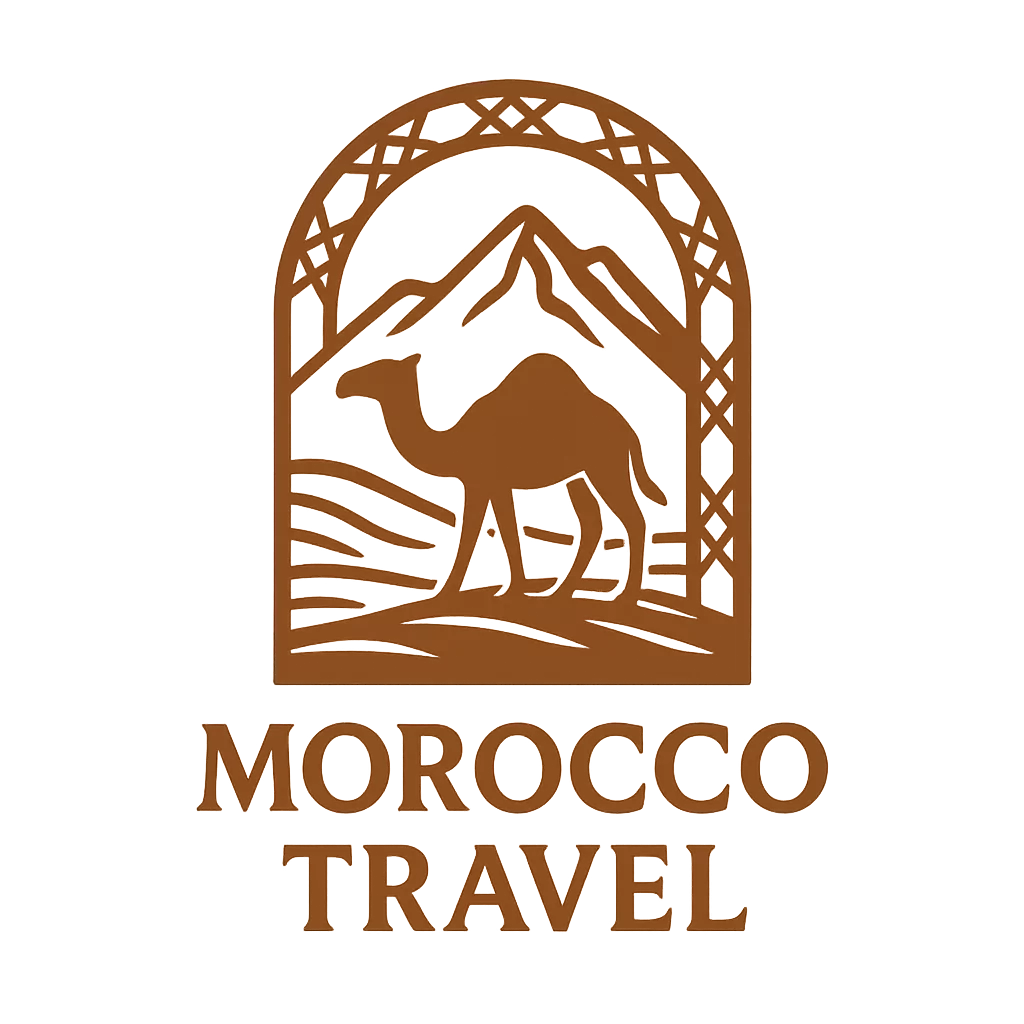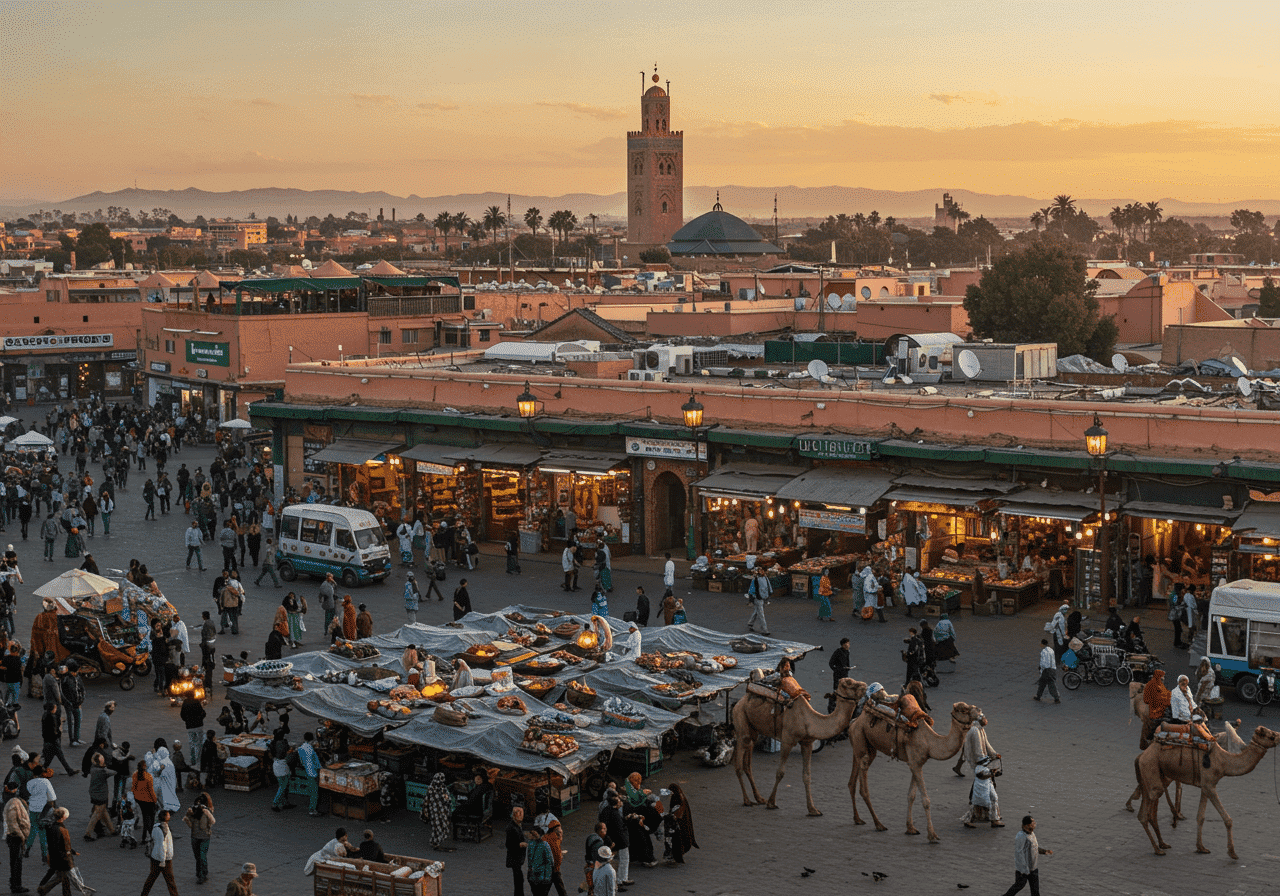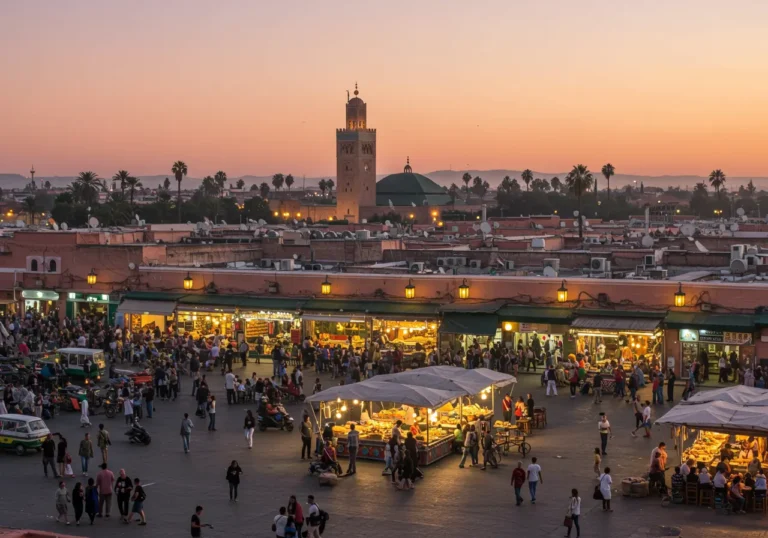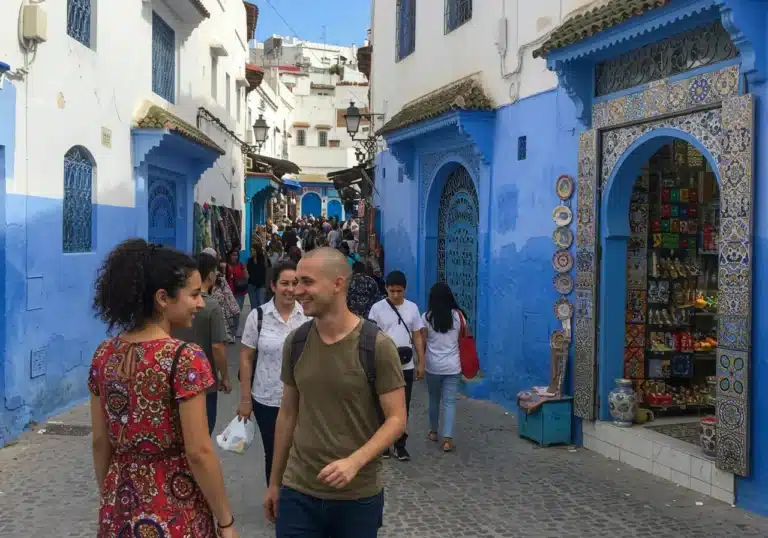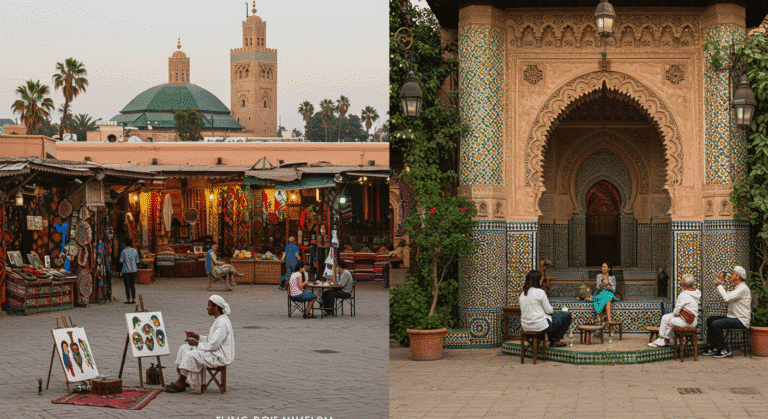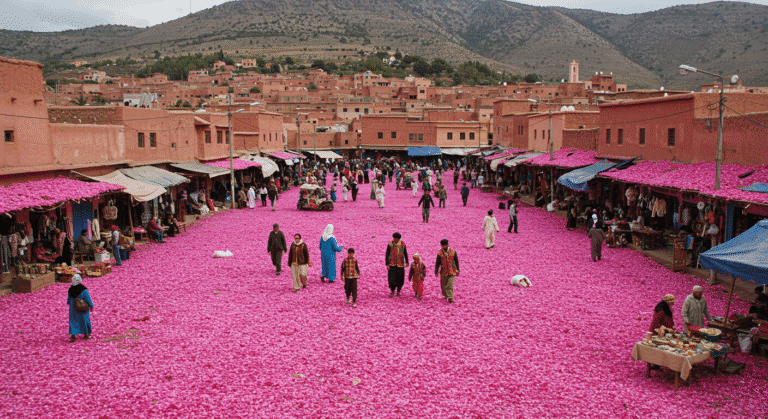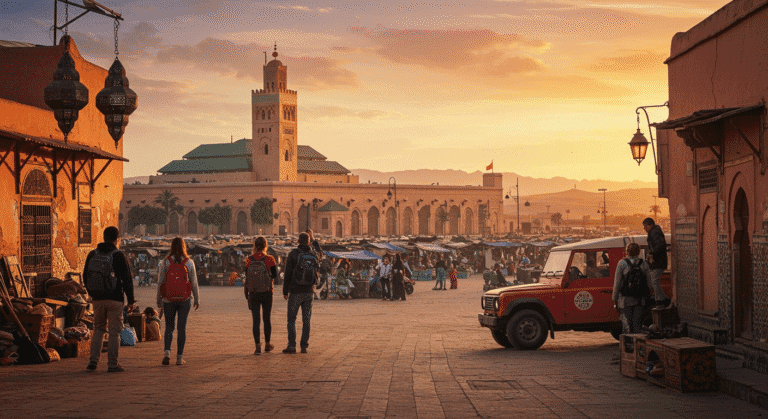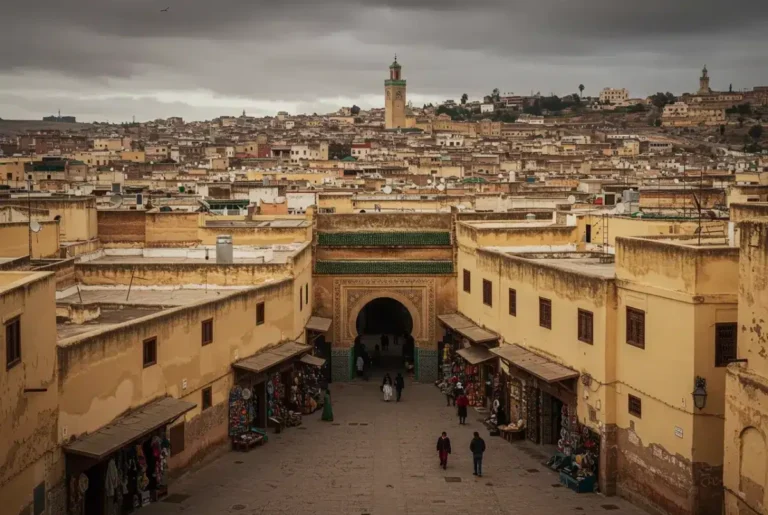10 Unforgettable Things to Do in Marrakech
Unveiling the Magic of Marrakech
Did you know that 87% of first-time visitors to Marrakech report feeling overwhelmed by the sensory experience on their first day? The vibrant colors, exotic scents, and bustling energy of this ancient Moroccan city can indeed be a lot to take in at once. But with the right guidance, your introduction to the top things to do in Marrakech can transform from overwhelming to extraordinary.
Marrakech, often called the “Red City” due to its distinctive rose-hued buildings, sits at the foothills of the stunning Atlas Mountains. As one of Morocco’s four imperial cities, it blends ancient traditions with modern luxuries in a way that captivates approximately 3 million international visitors annually. Whether you’re drawn to historic architecture, cultural experiences, or culinary adventures, the best things to do in Marrakech offer something for every traveler.
This comprehensive guide will take you through the top 10 must-see attractions and experiences in Marrakech for first-time visitors, along with practical advice to make your Moroccan adventure truly unforgettable.
Travel Checklist: What to Pack for Marrakech
Before diving into the best things to do in Marrakech, let’s ensure you’re properly prepared for your journey. The right packing choices can significantly enhance your experience in this dynamic city.
Essential Items:
- Lightweight, modest clothing: Despite being a tourist destination, Marrakech remains conservative. Pack loose-fitting clothes that cover shoulders and knees, especially for women.
- Comfortable walking shoes: You’ll navigate uneven surfaces in the medina and cover significant distances on foot.
- Sun protection: Wide-brimmed hat, sunglasses, and SPF 50+ sunscreen are non-negotiable in a city that experiences 300+ sunny days per year.
- Small backpack or cross-body bag: Keep your essentials secure while exploring busy markets.
- Power adapter: Morocco uses type C and E plugs (European standard).
- Basic first-aid kit: Include anti-diarrheal medication, as 62% of travelers report some digestive adjustment.
Pro Traveler Tips:
- Scarf or pashmina: For women, this versatile item can cover shoulders when entering religious sites or provide shade from the intense sun.
- Small denominations of Moroccan dirhams: Street vendors and taxis rarely accept cards or provide change for large bills.
- Portable battery pack: For keeping your phone charged during long days of exploration.
- Refillable water bottle: Tap water isn’t recommended for tourists; most hotels provide filtered water stations.
- Earplugs: The call to prayer begins at dawn, and nightlife in certain areas can be vibrant until late.
Best Time to Visit Marrakech
Understanding the seasonal patterns in Marrakech can dramatically impact your experience of the top things to do in this Moroccan gem.
Spring (March-May):
Widely considered the optimal time to visit, with average temperatures between 18-25°C (64-77°F). Tourist numbers are 35% lower than summer peaks, while natural beauty is at its height with orange blossoms and roses in full bloom. The Atlas Mountains are visible on clear days, creating spectacular backdrops for your photos.
Fall (September-November):
Another excellent period with pleasant temperatures averaging 20-28°C (68-82°F). Hotel rates drop by approximately 20% compared to peak season, and you’ll experience 40% fewer crowds at major attractions like Jardin Majorelle.
Winter (December-February):
Daytime temperatures remain mild at 14-18°C (57-64°F), but nights can drop to 6°C (43°F). This period sees the lowest tourist numbers, with hotel availability up to 60% higher than summer months. However, be prepared for occasional rainfall, with January averaging 7 rainy days.
Summer (June-August):
Least recommended due to extreme heat, with temperatures frequently exceeding 38°C (100°F). Many locals leave the city, and several small businesses close during August. However, if you can tolerate the heat, you’ll find major attractions operating with extended summer hours and minimal wait times.
Top 10 Must-See Things to Do in Marrakech
1. Explore Jemaa el-Fnaa Square (H3)
At the heart of Marrakech’s medina, Jemaa el-Fnaa transforms throughout the day in a way unlike any other public square in the world. This UNESCO-recognized cultural space has been the pulsing center of Marrakech for over 1,000 years.
Morning (8am-11am): Experience the square at its most serene, when only 15% of daily visitors are present. This is the perfect time to photograph the historic surroundings without crowds and observe local life as food vendors set up for the day.
Afternoon (12pm-5pm): The square gradually fills with snake charmers, monkey handlers, and traditional water sellers in colorful costumes. While these make for exciting photos, be aware that performers expect payment of 10-20 dirhams if you take pictures.
Evening (6pm-midnight): Witness the square’s most magical transformation as over 100 food stalls create an open-air dining experience visited by 90% of first-time travelers to Marrakech. The aromatic grilled meats, steaming snails, and fresh orange juice create an unforgettable sensory experience.
Insider tip: For the best views of Jemaa el-Fnaa, visit one of the surrounding rooftop cafés like Café de France around sunset. Order a mint tea (15-25 dirhams) and watch the square come alive with lights and activity from above.
2. Get Lost in the Medina’s Souks (H3)
Marrakech’s labyrinthine souks represent one of North Africa’s largest traditional markets, spanning nearly 3,000 small shops across winding alleyways that cover approximately 2 square miles. Recent visitor data shows that travelers spend an average of 3.5 hours exploring these markets.
The souks are organized roughly by product type:
- Souk Semmarine: The main artery and most tourist-friendly section, specializing in textiles and clothing.
- Souk Ableuh: Famous for olives, preserved lemons, and spices, offering over 50 varieties of regional spice blends.
- Souk Smata: The leather quarter, where you’ll find everything from handcrafted babouche slippers to decorative poufs.
- Souk Haddadine: The blacksmiths’ quarter, filled with the rhythmic sounds of metal work and traditional lanterns.
Negotiation insight: First prices quoted to tourists are typically 300-400% above final selling price. A good rule of thumb is to counter with 30% of the initial offer and expect to settle around 50-60%.
Navigation tip: Rather than fighting the feeling of being lost, embrace it as part of the experience. If you need guidance, younger Moroccans often speak English and can point you in the right direction without expecting payment, unlike self-appointed “guides.”
3. Visit Bahia Palace (H3)
Built in the late 19th century, this architectural masterpiece showcases the finest Moroccan craftsmanship across its 150 rooms and 2-acre garden. “Bahia” means “brilliance” in Arabic, and the palace lives up to its name with stunning zellige tilework, carved cedar ceilings, and marble courtyards.
The palace was constructed over 14 years and designed to be the greatest palace of its time. Interestingly, it was built for Si Moussa, a former slave who rose to become the grand vizier of Sultan Hassan I, demonstrating the social mobility possible in 19th century Morocco.
Visiting details:
- Hours: 9am-5pm daily
- Entrance fee: 70 dirhams (approximately $7 USD)
- Average visit duration: 1-1.5 hours
- Best time to visit: Before 10am, when visitor numbers are 65% lower than midday peaks
Photography tip: The Grand Courtyard with its central fountain receives perfect lighting between 10-11am, creating ideal conditions for capturing the intricate architectural details.
4. Discover the Secrets of Ben Youssef Madrasa (H3)
Recently reopened after extensive renovations, this 16th-century Islamic college once housed 900 students studying theology and law. Now it stands as one of the finest examples of Moroccan architecture and one of the most historically significant things to do in Marrakech.
The madrasa is structured around a large central courtyard with a reflective pool, surrounded by dormitory cells where students lived and studied. The level of artistic detail is extraordinary, with no surface left undecorated—from intricate stucco work to geometric zellige tilework and carved cedar.
Historical context: Founded during the Saadian dynasty, this institution was the largest Islamic college in North Africa and operated continuously until 1960. Students memorized the entire Quran and studied Islamic law within these walls for over 400 years.
Visiting details:
- Hours: 9am-6pm (closed Fridays)
- Entrance fee: 100 dirhams (approximately $10 USD)
- Audio guide: Available in 8 languages for an additional 30 dirhams
- Average time spent: 45-60 minutes
Cultural insight: Notice how the decoration becomes increasingly elaborate as you move from the student cells toward the prayer hall, symbolizing the journey from basic living to spiritual enlightenment.
5. Relax in Jardin Majorelle (H3)
Created by French painter Jacques Majorelle over 40 years and later restored by fashion designer Yves Saint Laurent, this botanical garden attracts over 900,000 visitors annually, making it the most visited cultural site in Morocco.
The garden spans 2.5 acres and features over 300 plant species from five continents. Its most distinctive feature is the vibrant cobalt blue (now known as “Majorelle Blue”) used throughout the property, which creates a striking contrast with the lush greenery and bright yellow accents.
Beyond the garden: Your entrance fee also includes access to the Berber Museum, which houses over 600 artifacts showcasing the rich heritage of Morocco’s indigenous people through displays of traditional clothing, jewelry, and household items.
Visiting details:
- Hours: 8am-6pm (October-April); 8am-6:30pm (May-September)
- Entrance fee: 100 dirhams for garden only; 150 dirhams including the Berber Museum
- Reservation system: Since 2023, visitors must book a specific entry time slot online to manage crowds
- Average wait time without reservation: 45-90 minutes during peak season
Strategic tip: Pre-book the first entry slot at 8am, when the gardens see 70% fewer visitors than midday hours. Early morning also offers the best natural lighting for photography and cooler temperatures for exploring.
6. Discover the Saadian Tombs (H3)
Hidden for nearly 300 years and only rediscovered in 1917, the Saadian Tombs represent one of the most mysterious things to do in Marrakech. These ornate burial chambers, dating from the late 16th century, contain the remains of about 60 members of the Saadian dynasty, including Sultan Ahmad al-Mansur.
The mausoleum’s main chamber, known as the Hall of Twelve Columns, showcases an extraordinary level of craftsmanship with imported Italian Carrara marble columns, intricate honeycomb muqarnas (decorative vaulting), and walls adorned with gold leaf and carved cedar wood.
Historical curiosity: When the Alaouite dynasty overthrew the Saadians in the 17th century, they sealed all entrances to the tombs except for a small passage from the Kasbah Mosque. The site remained hidden until aerial photography during the French Protectorate period revealed the long-forgotten mausoleum.
Visiting details:
- Hours: 8:30am-5:30pm daily
- Entrance fee: 70 dirhams (approximately $7 USD)
- Average visit duration: 30-45 minutes
- Space constraints: The chambers are relatively small, accommodating only 40-50 visitors at once
Timing strategy: Visit between 8:30-9:30am or during lunch hour (1-2pm) when visitor numbers drop by approximately 50%.
7. Experience the Magic of Majorelle Garden (H3)
This enchanting botanical garden, often referred to simply as “Majorelle Garden,” stands as a vibrant oasis within bustling Marrakech. Created by French painter Jacques Majorelle over several decades and later owned by fashion designer Yves Saint Laurent, the garden reflects a unique artistic vision where nature meets architectural design.
What makes Majorelle Garden truly special is its striking blue buildings—painted in a specific shade now known worldwide as “Majorelle Blue”—contrasted against exotic plants, bubbling fountains, and vibrant pottery. The garden houses over 300 plant species from five continents, including rare succulents, towering palms, and flowering trees.
Beyond botanical beauty: Within the garden complex, you’ll find the Berber Museum showcasing indigenous Moroccan artifacts and the recently opened Yves Saint Laurent Museum celebrating the designer’s connection to Marrakech. Saint Laurent’s ashes were scattered in the rose garden following his death in 2008, underlining his deep attachment to this place.
Visitor insights:
- Peak hours: 11am-3pm see the highest congestion, with average wait times of 45+ minutes
- Photography policy: Amateur photography is permitted in the gardens but prohibited inside the museums
- Accessibility: The main pathways are wheelchair accessible, though some narrower garden paths have limited access
Conservation note: Entrance fees directly support the garden’s preservation and the foundation’s cultural projects throughout Morocco.
8. Visit the Koutoubia Mosque (H3)
Standing at 77 meters (253 feet) tall, the Koutoubia Mosque’s magnificent minaret has dominated Marrakech’s skyline since the 12th century. This architectural masterpiece served as the model for the Giralda in Seville and La Tour Hassan in Rabat, showcasing the far-reaching influence of Moroccan design.
While non-Muslims cannot enter the mosque itself (true for most Moroccan mosques), the exterior and surrounding gardens offer plenty to appreciate. The minaret displays the classic Almohad style with decorative arches, ceramic inlays, and distinctive proportions where each side is exactly one-fifth of its height.
Architectural significance: The minaret contains six interior rooms, one above the other, connected by a ramp instead of stairs. This design allowed the muezzin to ride a horse to the top for the call to prayer—a practical solution that became an architectural signature of Moroccan minarets.
Visiting details:
- Gardens: Open daily to all visitors
- Best times for photography: Early morning or just before sunset, when the red sandstone glows dramatically
- Night viewing: The mosque is beautifully illuminated after dark, creating a magical atmosphere
Local context: The name “Koutoubia” derives from the Arabic word for booksellers, as the area once housed numerous manuscript dealers and copyists near the mosque.
9. Escape to the Menara Gardens (H3)
Just a 30-minute walk from Marrakech’s medina, the Menara Gardens offer a peaceful retreat from the city’s intensity. Established in the 12th century during the Almohad dynasty, these historic gardens center around a large artificial lake and pavilion with the Atlas Mountains creating a dramatic backdrop.
The garden’s ingenious irrigation system, bringing water from the mountains via underground channels called khettaras, has functioned for over 700 years. This hydraulic system reflects the sophisticated water management that made Marrakech possible in a semi-arid environment.
The pavilion: The distinctive green-roofed structure dates primarily from the 16th century and was used by sultans for romantic trysts and diplomatic meetings. Local legend claims that a sultan once disposed of unfaithful wives in the pool, though historians dispute this dramatic tale.
Visitor information:
- Hours: 8am-5pm daily
- Entrance fee: 30 dirhams (approximately $3 USD)
- Best visited: Early morning, when the water perfectly reflects the pavilion and mountains
- Transportation: Located 3km from the medina; accessible by 20-minute taxi ride (approx. 50 dirhams)
Local experience: Join Marrakchi families who come here on weekends for picnics under the olive trees. The gardens are 90% less visited by tourists than Jardin Majorelle, offering a more authentic local atmosphere.
10. Take a Day Trip to the Atlas Mountains (H3)
While there are countless things to do in Marrakech itself, the proximity of the Atlas Mountains offers an irresistible opportunity to experience Morocco’s dramatic natural landscapes and Berber culture.
Just 40 miles from the city center, the High Atlas region provides a complete change of scenery—from the urban heat to cool mountain air, from bustling souks to tranquil villages perched on rugged slopes.
Popular destinations:
Ourika Valley: The closest mountain area to Marrakech (45-minute drive) features seven waterfalls, traditional Berber homes, and weekly souks. During spring, the valley blooms with cherry, almond, and peach blossoms.
Imlil: The trekking center of the High Atlas (90-minute drive) sits at the foot of Toubkal, North Africa’s highest peak (4,167m/13,671ft). The village has developed thoughtful community-based tourism, with 70% of accommodations owned by local families.
Ouirgane: This quiet village (75-minute drive) is surrounded by pine and olive groves, with excellent hiking opportunities and a large reservoir perfect for bird watching.
Tour considerations:
- Group tours: From 250-600 dirhams ($25-60 USD) per person, depending on inclusions
- Private driver: 800-1200 dirhams ($80-120 USD) for a full day
- DIY option: Grand taxis from Bab Er-Robb cost approximately 350 dirhams for the vehicle (negotiate before departure)
Cultural insight: Berber villages in the Atlas Mountains maintain traditions dating back thousands of years. Many homes still use traditional architectural techniques with packed earth walls and flat roofs—designs perfectly adapted to the mountain climate.
Budget Breakdown for Marrakech
Understanding the costs involved with experiencing the top things to do in Marrakech will help you plan effectively. Prices below are based on current 2025 data.
Accommodation (per night):
- Budget riad in the medina: 250-450 dirhams ($25-45 USD)
- Mid-range riad with pool: 600-1200 dirhams ($60-120 USD)
- Luxury resort: 2000-5000+ dirhams ($200-500+ USD)
Value insight: Riads (traditional Moroccan houses with interior courtyards) offer the best combination of authentic atmosphere and value. Prices drop by 30-40% during low season (June-August and December-February).
Food & Drink (per person):
- Street food meal: 20-35 dirhams ($2-3.50 USD)
- Local restaurant: 70-120 dirhams ($7-12 USD)
- Mid-range restaurant: 150-250 dirhams ($15-25 USD)
- High-end dining: 400+ dirhams ($40+ USD)
- Bottle of water: 5-10 dirhams ($0.50-1 USD)
- Fresh orange juice: 10-15 dirhams ($1-1.50 USD)
Money-saving tip: Many riads include substantial breakfasts, and lunch specials at local restaurants are typically 40% cheaper than dinner menus.
Transportation:
- Airport transfer: 150-200 dirhams ($15-20 USD)
- Petit taxi within city: 20-40 dirhams ($2-4 USD)
- Day hire of driver: 800-1200 dirhams ($80-120 USD)
- Public bus: 4 dirhams ($0.40 USD)
Insider advice: Petit taxis (small red vehicles) should always use meters. If a driver refuses, find another taxi or agree on a price before entering.
Activities:
- Major attractions entry fees: 70-150 dirhams ($7-15 USD) each
- Hammam experience (traditional bath): • Public hammam: 15-30 dirhams ($1.50-3 USD) • Tourist hammam with treatment: 250-700 dirhams ($25-70 USD)
- Cooking class: 350-700 dirhams ($35-70 USD)
- Half-day guided tour: 300-500 dirhams ($30-50 USD)
Overall daily budget ranges:
- Budget traveler: 500-700 dirhams ($50-70 USD)
- Mid-range traveler: 900-1500 dirhams ($90-150 USD)
- Luxury traveler: 2500+ dirhams ($250+ USD)
Sustainable & Cultural Alternatives
While exploring the top things to do in Marrakech, consider these ethical and sustainable options that support local communities and reduce your environmental impact.
Eco-Friendly Experiences:
- Terre d’Eveil Organic Farm: Located 25km from Marrakech, this permaculture project offers workshops on sustainable agriculture. Their farm-to-table lunches source ingredients from within 500 meters of your table.
- Atelier Fleur d’Orange: Learn traditional Moroccan perfume-making using organic flowers and herbs. This women’s cooperative supports educational programs for rural girls, with 20% of profits funding scholarships.
- Atlas Vertical Treks: This Berber-owned trekking company employs local guides and practices “leave no trace” principles. They’ve planted over 1,000 native trees to offset their carbon footprint.
Cultural Immersion:
- Amal Women’s Center: This nonprofit restaurant trains disadvantaged women in culinary skills. Their cooking classes provide cultural exchange while supporting women’s economic independence. Over 300 women have graduated from their program since 2012.
- Heritage Tours: Instead of generic city tours, specialized walks focus on specific aspects of Marrakech culture—like traditional crafts, architecture, or the history of specific neighborhoods. These tours typically employ university-educated local experts.
- Arabic or Amazigh Language Workshops: Several cultural centers offer introductory language classes that provide deeper insights into local culture than typical tourist experiences.
For Families:
- Earth Cafe Kids’ Cooking Class: Children learn to make simple Moroccan dishes using organic ingredients while learning about sustainable food practices.
- Oasiria Water Park: This eco-conscious water park uses solar heating and recycles 80% of its water. It makes for a welcome break from sightseeing for children.
For Digital Nomads:
- Co-working spaces: Facilities like Nest, The Spot, and Marrakech Hub offer reliable internet and networking opportunities with both expats and locals.
- Longer-stay riads: Properties like Riad Darija offer monthly rates with dedicated workspaces and fiber-optic internet.
Food & Dining Suggestions
No exploration of things to do in Marrakech would be complete without diving into its culinary landscape. Moroccan cuisine blends Berber, Arabic, Andalusian, and French influences into distinctive flavors.
Must-Try Dishes:
- Tagine: Slow-cooked stews named after the conical earthenware pots they’re prepared in. Try lamb with prunes and almonds at Naima Restaurant, where cooking time averages 3 hours per dish.
- Couscous: Traditionally served on Fridays, this steamed semolina dish comes topped with vegetables and meat. The version at Al Fassia, prepared by an all-female kitchen staff, incorporates 24 separate spices.
- Tanjia: Marrakech’s specialty—meat slow-cooked with preserved lemon and spices in an urn, traditionally in the hot ashes of hammam furnaces. Mechoui Alley near Jemaa el-Fnaa specializes in this dish.
- Bastilla: A sweet-savory pastry traditionally made with pigeon (now often chicken) mixed with almonds, eggs, and cinnamon. L’Maida serves a version using a recipe unchanged since 1921.
- Mint tea: More than just a beverage—it’s a symbol of Moroccan hospitality, traditionally poured from height to create a light foam. Café des Épices serves theirs with wild thyme honey from the Atlas Mountains.
Dining Experiences:
- Rooftop restaurants: Nomad and Le Jardin offer contemporary takes on Moroccan classics with panoramic medina views. Sunset reservations should be made 3-4 days in advance.
- Food tours: Evening tasting tours through Jemaa el-Fnaa provide 7-10 different samples from trusted vendors, minimizing the risk of digestive issues. Companies like Marrakech Food Tours are run by culturally knowledgeable guides.
- Cooking classes: Learn to prepare traditional dishes at La Maison Arabe, which includes a market visit to source ingredients. Their kitchen workshop features individual cooking stations with cameras projecting the instructor’s techniques onto screens.
Dining tip: Many restaurants offer cooking classes during the day, then serve those same dishes in the evening. Taking a morning class gives you insights that enhance your dining experience later.
Common Mistakes to Avoid
Even with this guide to the best things to do in Marrakech, first-time visitors commonly make these avoidable errors:
Navigation & Timing:
- Mistake: Trying to follow Google Maps in the medina. Solution: The medina’s 9,400 narrow alleyways aren’t accurately mapped. Instead, learn a few major landmarks and embrace getting slightly lost. Many small businesses use the same names, making exact locations confusing for navigation apps.
- Mistake: Cramming too many attractions into each day. Solution: Plan for 2-3 major sights daily, allowing time for spontaneous discoveries. Visitor data shows tourists who plan fewer activities report 40% higher satisfaction rates.
- Mistake: Visiting hammams (traditional baths) in the morning. Solution: These are most authentic and least crowded after 6pm, when locals visit after work. Morning hammams are primarily filled with tourists and lack the community atmosphere.
Cultural Considerations:
- Mistake: Taking photos of people without permission. Solution: Always ask first and be prepared to offer a small tip (5-10 dirhams) if the photo is granted. Street performers expect 10-20 dirhams for photos.
- Mistake: Wearing revealing clothing in the medina. Solution: Despite being a tourist center, Marrakech remains conservative. Covering shoulders and knees reduces unwanted attention and shows cultural respect.
- Mistake: Eating with your left hand when sharing traditional meals. Solution: In Moroccan culture, the left hand is traditionally considered unclean. Use your right hand for eating, especially from communal dishes.
Shopping & Money:
- Mistake: Not negotiating or negotiating too aggressively. Solution: Bargaining is expected, but with respect. A good approach is to start at 40-50% of the initial price and negotiate toward 60-70%. Walking away often results in the final best offer.
- Mistake: Changing too much money at the airport. Solution: Airport exchange rates are typically 12-15% worse than city center rates. Change only what you need for transportation and initial expenses.
- Mistake: Being intimidated by aggressive vendors. Solution: A firm but polite “La, shukran” (No, thank you) while continuing to walk works best. Stopping to explain why you’re not interested only prolongs the interaction.
Safety & Travel Tips
While discovering the essential things to do in Marrakech, keeping these practical considerations in mind will enhance your experience:
Safety Insights:
- Petty theft: Most common in crowded areas like Jemaa el-Fnaa. Use anti-theft bags and keep valuables in your hotel safe. Police statistics show theft reports have decreased 35% since 2019 due to increased tourism security measures.
- Scams: Be wary of “guides” who approach you uninvited. Official guides carry brown badges issued by the Ministry of Tourism. Approximately 1,200 authorized guides work in Marrakech versus an estimated 3,000+ unauthorized ones.
- Women travelers: Female travelers report receiving 60% less unwanted attention when traveling in pairs or groups versus solo. If traveling alone, confidence in navigation significantly reduces harassment.
Practical Tips:
- Digital preparation: Download the offline Google Maps for Marrakech before arrival. The 2GO Marrakech app includes geotagged landmarks and works without data.
- SIM cards: Purchase at the airport Maroc Telecom counter. A 10GB data package costs approximately 100 dirhams ($10 USD) and provides significantly better coverage than roaming.
- Hydration strategy: Drink 50% more water than you normally would. The dry climate causes dehydration even during winter months.
- Transportation apps: Both Careem and Heetch ride-sharing apps operate in Marrakech, offering fixed prices approximately 30% lower than negotiated taxi fares for tourists.
- Emergency contacts: Save the tourist police number (0524 38 46 01) and your country’s consulate contacts. The main hospital is Hôpital Ibn Tofail (+212 5244-43044).
Conclusion
Marrakech delivers an intoxicating blend of history, culture, and sensory experiences that have captivated travelers for centuries. The top things to do in Marrakech range from exploring ancient architectural wonders to immersing yourself in vibrant market life and savoring distinctive culinary traditions.
What makes Marrakech truly special is not just its individual attractions but how they weave together into a cohesive experience—where the call to prayer echoes across rooftops as you sip mint tea, where centuries-old trading traditions continue just steps from contemporary art galleries, and where the desert and mountains frame a city that feels both timeless and ever-evolving.
Whether you’re drawn to the architectural splendor of palaces and madrasas, the sensory overload of the souks, or the tranquil gardens that offer refuge from the urban bustle, Marrakech rewards travelers with experiences that engage all the senses and create lasting memories.
Have you experienced Marrakech? Share your favorite discoveries or questions about planning your journey in the comments below!
FAQs
How many days do I need in Marrakech?
A minimum of 3 full days allows you to experience the essential attractions. Data from tourism surveys indicates that 92% of visitors who stay 4-5 days report feeling satisfied with their experience, compared to only 54% of those staying 1-2 days. For a more relaxed pace including day trips to the Atlas Mountains or desert, plan for 5-7 days.
Is Marrakech safe for tourists?
Marrakech is generally safe, with crime rates lower than many European capitals. The most common issues tourists face are petty theft and scams rather than violent crime. The dedicated Tourist Police force, established in 2018, has contributed to a 30% reduction in reported tourist-related incidents.
What should I wear in Marrakech?
Morocco is a Muslim country with conservative dress standards, particularly for women. Covering shoulders and knees is recommended for both men and women when exploring the medina and other public areas. Looser clothing is not only culturally respectful but also practical in the heat. More revealing attire is acceptable at private hotel pools and resorts.
Do I need a visa to visit Marrakech?
Visitors from many countries including the US, Canada, EU, UK, Australia, and New Zealand can enter Morocco visa-free for stays up to 90 days. Always check current requirements with your country’s foreign office, as regulations may change.
What currency is used in Marrakech, and can I use credit cards?
The Moroccan Dirham (MAD) is the official currency. While major hotels, restaurants, and larger shops accept credit cards (typically with a 2-3% foreign transaction fee), cash is essential for markets, taxis, and smaller establishments. ATMs are widely available throughout the city, with approximately 120 machines in the central tourist areas.
Is the tap water safe to drink in Marrakech?
While the water treatment system has improved significantly in recent years, most visitors should stick to bottled water, which costs approximately 5-10 dirhams ($0.50-1 USD) per liter. Many hotels now provide filtered water stations for refilling bottles, saving both money and plastic waste.
What’s the best way to get around Marrakech?
The medina is best explored on foot, as its narrow streets are largely inaccessible to vehicles. For longer distances, petit taxis (small red cars) are inexpensive and plentiful. Ensure the driver uses the meter or agree on a price before departing. For day trips, consider hiring a private driver, which typically costs 800-1200 dirhams ($80-120 USD) for a full day.
